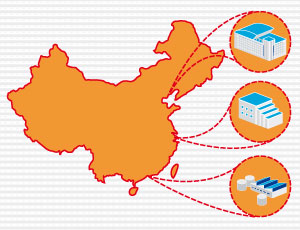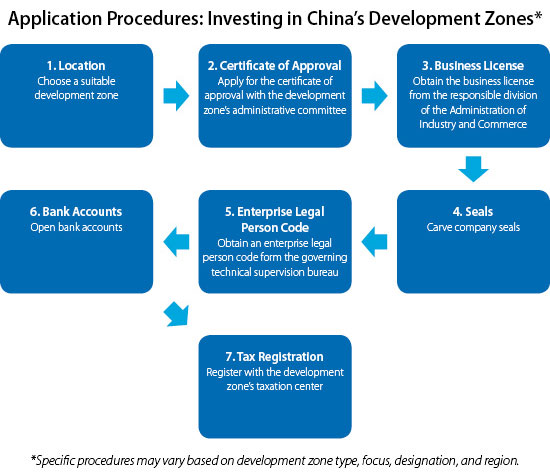Utilizing Development Zones in China
By Christian Fleming and Shirley Zhang
 May 28 – Development zones are not a Chinese creation, but China in particular has found tremendous success with this economic tool. Historically, the liberal business environment in these areas have allowed foreign enterprises to operate more comfortably in the Chinese business environment, sheltered from the bureaucracy and red tape that often characterizes the rest of the country while at the same time such businesses could benefit from preferential policies, greater resource availability, and prime locations within regional hubs of creativity and innovation.
May 28 – Development zones are not a Chinese creation, but China in particular has found tremendous success with this economic tool. Historically, the liberal business environment in these areas have allowed foreign enterprises to operate more comfortably in the Chinese business environment, sheltered from the bureaucracy and red tape that often characterizes the rest of the country while at the same time such businesses could benefit from preferential policies, greater resource availability, and prime locations within regional hubs of creativity and innovation.
The country’s first development zones came in the form of special economic zones (SEZs) located along the country’s southern coastal cities of Shenzhen, Zhuhai, Shantou and Xiamen to act as demonstration sites for the government to attract FDI and test whether the formerly centrally-planned economy could transition to a more liberal and capitalist model. In particular, these zones focused on aiding export manufacturing to bolster the local economy without posing too significant a threat to state-owned enterprises.
However, these original SEZs may be less relevant today since a wide variety of alternative development zones have emerged and foreign investment in China now pours into all regions of the country. Also, China’s 2008 Corporate Income Tax (CIT) Reform reversed many of the key tax incentives that were previously offered. Finally, foreign companies are no longer solely focused on exporting, for which development zones were originally designed, and are increasingly interested in domestic sales. Regardless, the convenience of established infrastructure, reserved land and one-stop services available in development zones streamlines entry into China.
Development Zones by Type
The largest and most comprehensive types of development zones in China are SEZs and economic and technological development zones (ETDZs). However, while SEZs and ETDZs are technically development zones, large in scope and focus, some of the key tax incentives that made these terrific options in the 1980s and 1990s have all but dried up with recent tax reforms.
Therefore, it is important to keep in mind that larger doesn’t always mean better when considering development zones in China, and foreign investors looking for specific services or tailored benefits to meet their business needs may find it more helpful to look at the smaller, more focused types of development zones such as high-tech industrial development zones (HTDZs) or export processing zones (EPZs). We go through the key characteristics, advantages and disadvantages of China’s primary development zones below.
Special Economic Zones
There are currently six SEZs in China. In 1980, the first special economic zone of China was established in Shenzhen, which covered all four districts of the city and almost 400 square kilometers in total. A series of preferential policies to attract foreign investors, such as autonomous operating rights, tax incentives and other beneficial policies were introduced, and financing, commercial, and tourism facilities were also built to accommodate the coming foreign investors. In the following years, China replicated this model in a number of other cities, allowing SEZs to enjoy a great deal of autonomy in formulating legislation friendly to the zone’s purpose. In this environment, the SEZs attained rapid growth and are now superlatively strong targets for foreign investment.
However, the 2008 CIT Reform ended most of the SEZ-specific tax incentives, including the 15 percent CIT rate and other preferential tax policies. For the past three decades, though, smaller development zones such as economic and technological development zones, bonded zones and export processing zones have been built within SEZs to create new incentives. Furthermore, the flexible legislation, advanced infrastructure and great locations still make SEZs highly sought-after investment regions.
Economic and Technological Development Zones
ETDZs are locations designed to grow technology-intensive industries and hand out incentives like government funding or rewards to investments in the industrial sector as well as emerging industries. In 1984, China officially decided to open up 14 harbor cities along the coast, and 17 ETDZs were built in these cities. As China continued to grow and open its markets, more ETDZ were established in different regions. Currently, there are more than 100 national ETDZs in China. The advantages of investing in ETDZs include great locations, access to local markets, advanced infrastructure and strong talent pools. Some ETDZs include high-tech industrial development zones, export processing zones or bonded zones. Today, they double as fully functional residential areas with schools, residence buildings, tourist sites and entertainment facilities.
High-Tech Industrial Development Zones
HTDZs are specific areas typically aimed at commercializing research and development and encouraging specific technology-heavy industries, including IT, electronics, pharmaceuticals and new materials. These zones are generally quite similar to ETDZs, but benefit from additional incentives for innovation. Although many of the old SEZ-specific incentives are gone, qualified high-tech enterprises still enjoy the 15 percent CIT rate regardless of location. Development zones generally provide a better-than-average environment in manufacturing, financing and residential development for investors, and so remain a highly preferred target for foreign investment.
Free Trade Zones
FTZs are designated areas for export processing, international trade and bonded operations. They generally include industrial parks, bonded warehouses and export processing zones. They are usually established according to free trade agreements signed between China and other countries, which makes goods or services traded within the zone eligible for zero-rated or preferential rates on customs duties. Trade quotas are also removed within FTZs.
Enterprises in these zones can receive tax refunds on value-added tax for either exports or imports. They also make labor movement among related countries much easier with more convenient visa formality procedures. China currently participates in FTAs with 20 different countries, and Shanghai is planning to build the mainland’s first FTZ in Pudong.
Export Processing Zones
EPZs are essentially smaller-scale and simplified FTZs, generally located within an existing development zone for the purpose of export processing. EPZs are subject to restrictive terms regarding the manufacturing of goods for sale in local markets.
Key advantages of EPZs include exemptions from import and export duties and VAT refunds, easier foreign exchange and customs declaration procedures, and no quota limits.
Bonded Logistic Zones
Traditionally located near ports or airports to facilitate aggregation of shipments or assembly, BLZs are areas where specific logistic activities subject to unique customs taxes can be executed. Rent is generally higher, and these areas are not intended for setting up factories or manufacturing bases.
Because BLZs are used for storage, certain processing, import and export customs duties are exempted, and trade quotas will not apply if imported goods are later exported. However, imported goods intended for domestic markets will still be subject to import duties and other relevant taxes.
There is no limit on how long the goods can be stored, making BLZs prime locations for trading companies and purchasing centers for foreign enterprises. BLZs also provide platforms for foreign enterprises to display their products without being subject to Chinese taxes. More efficient customs processes are also applied to goods exported from BLZs. Enterprises that use this type of zone need to go through customs only once when entering the zone.
Cross-Border Economic Zones
CBEZs are designed to develop trade and export processing industries at China’s border areas, usually building cooperation zones and encouraging joint-projects with neighboring countries. Preferential tax and tariff policies, such as special VAT refunds for reinvesting in the enterprise and other government rewards, are generally offered to attract investment.
Application Procedures
In the flow-chart below, we outline the typical application process for foreign-invested enterprises looking to operate within a development zone in China. However, it is important to note that there are no unified rules regulating the application process, and some steps may vary depending on the individual zone’s type, level, designation and focus.
For help deciding which development zone is right for your business, and to fully understand the specific application procedures in the zone you end up choosing, foreign investors are encouraged to contact a China-based consultancy.

 Portions of this article came from the current May/June 2013 issue of Asia Briefing Magazine, titled An Introduction to Development Zones Across Asia. In this issue of Asia Briefing Magazine, we break down the various types of development zones available in China, India and Vietnam specifically, as well as their key characteristics and leading advantages. This magazine will be available as a complimentary download through the months of May and June 2013.
Portions of this article came from the current May/June 2013 issue of Asia Briefing Magazine, titled An Introduction to Development Zones Across Asia. In this issue of Asia Briefing Magazine, we break down the various types of development zones available in China, India and Vietnam specifically, as well as their key characteristics and leading advantages. This magazine will be available as a complimentary download through the months of May and June 2013.
Dezan Shira & Associates is a specialist foreign direct investment practice, providing corporate establishment, business advisory, tax advisory and compliance, accounting, payroll, due diligence and financial review services to multinationals investing in emerging Asia. Since its establishment in 1992, the firm has grown into one of Asia’s most versatile full-service consultancies with operational offices across China, Hong Kong, India, Singapore and Vietnam as well as liaison offices in Italy and the United States.
For further details or to contact the firm, please email china@dezshira.com, visit www.dezshira.com, or download the company brochure.
You can stay up to date with the latest business and investment trends across Asia by subscribing to Asia Briefing’s complimentary update service featuring news, commentary, guides, and multimedia resources.
Related Reading
 Trading With China
Trading With China
This issue of China Briefing Magazine focuses on the minutiae of trading with China – regardless of whether your business has a presence in the country or not. Of special interest to the global small and medium-sized enterprises, this issue explains in detail the myriad regulations concerning trading with the most populous nation on Earth – plus the inevitable tax, customs and administrative matters that go with this.
 Expanding Your China Business to India and Vietnam
Expanding Your China Business to India and Vietnam
The March/April issue of Asia Briefing Magazine discusses why China is no longer the only solution for export driven businesses, and how the evolution of trade in Asia is determining that locations such as Vietnam and India represent competitive alternatives. With that in mind, we examine the common purposes as well as the pros and cons of the various market entry vehicles available for foreign investors interested in Vietnam and India.
- Previous Article China and Switzerland Sign MOU on Free Trade Agreement
- Next Article Singapore Launches RMB Clearing Service









